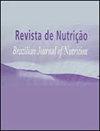Healthy and Safe School Cafeteria Program: a randomized controlled study
IF 0.5
4区 医学
Q4 NUTRITION & DIETETICS
Revista De Nutricao-brazilian Journal of Nutrition
Pub Date : 2022-01-01
DOI:10.1590/1678-9865202235e210265
引用次数: 0
Abstract
ABSTRACT Objective To assess the effect of an educational intervention program focused on health risk conditions, based on an assessment of the hygiene and quality of food sold in school cafeterias. Methods This is a controlled, parallel, randomized, two-arm, community study. Public and private schools with cafeterias were invited to participate. This study was conducted in 27 school cafeterias in northern and northwestern Rio Grande do Sul, a state in southern Brazil. Representatives of the school communities in the intervention group received an educational program consisting of 160-hour distance training. The most relevant outcomes were the assessment of the hygienic conditions and composition of the menus sold in school cafeterias. All outcomes were analyzed as intention-to-treat and per-protocol. For the analysis of continuous data with normal distribution, an analysis of covariance and the Generalized Linear Model were used. The level of statistical significance considered was p<0.05 for a 95% CI. Results No statistically significant difference was observed between the intervention group and the control group in the studied outcomes. There was a reduction of 76.2 points in the score for hygienic handling conditions (95% CI: -205 to 357; p=0.581). Regarding menu composition, the difference between groups was 0.48% (95% CI: -2.69 to 3.64; p=0.760) for ultra-processed foods, 0.23% (95% CI: -1.13 to 1.60; p=0.740) for processed foods, and 1.02% (95% CI: -2.59 to 4.64; p=0.581) for fresh foods. Conclusion There is not enough evidence to conclude that the intervention had a positive impact on any of the outcomes studied.健康和安全的学校食堂计划:一项随机对照研究
【摘要】目的通过对学校食堂食品卫生和质量的评估,评估健康风险状况教育干预方案的效果。方法采用对照、平行、随机、双组、社区研究。设有自助餐厅的公立和私立学校被邀请参加。这项研究是在巴西南部南格兰德州北部和西北部的27所学校食堂进行的。干预组的学校社区代表接受了一个由160小时远程培训组成的教育计划。最相关的结果是对学校食堂出售的卫生条件和菜单组成的评估。所有结果均按意向治疗和方案分析。对于正态分布的连续数据分析,采用协方差分析和广义线性模型。考虑的统计学显著性水平为p<0.05, 95% CI。结果干预组与对照组的研究结果无统计学差异。卫生处理条件的得分降低了76.2分(95% CI: -205至357;p = 0.581)。关于菜单组成,组间差异为0.48% (95% CI: -2.69 ~ 3.64;p=0.760),为0.23% (95% CI: -1.13至1.60;p=0.740),为1.02% (95% CI: -2.59至4.64;P =0.581)。没有足够的证据表明干预对研究的任何结果都有积极的影响。
本文章由计算机程序翻译,如有差异,请以英文原文为准。
求助全文
约1分钟内获得全文
求助全文
来源期刊
CiteScore
1.20
自引率
12.50%
发文量
24
审稿时长
6-12 weeks
期刊介绍:
Revista de Nutrição is former Revista de Nutrição da Puccamp, founded in 1988. It is a bimonthly publication every four months and it is of responsibility of the Centro de Ciências da Vida, da Pontifícia Universidade Católica de Campinas . It publishes articles that contribute to the study of Nutrition in its many sub-areas and interfaces; and is open to contributions of the national and international scientific communities.

 求助内容:
求助内容: 应助结果提醒方式:
应助结果提醒方式:


